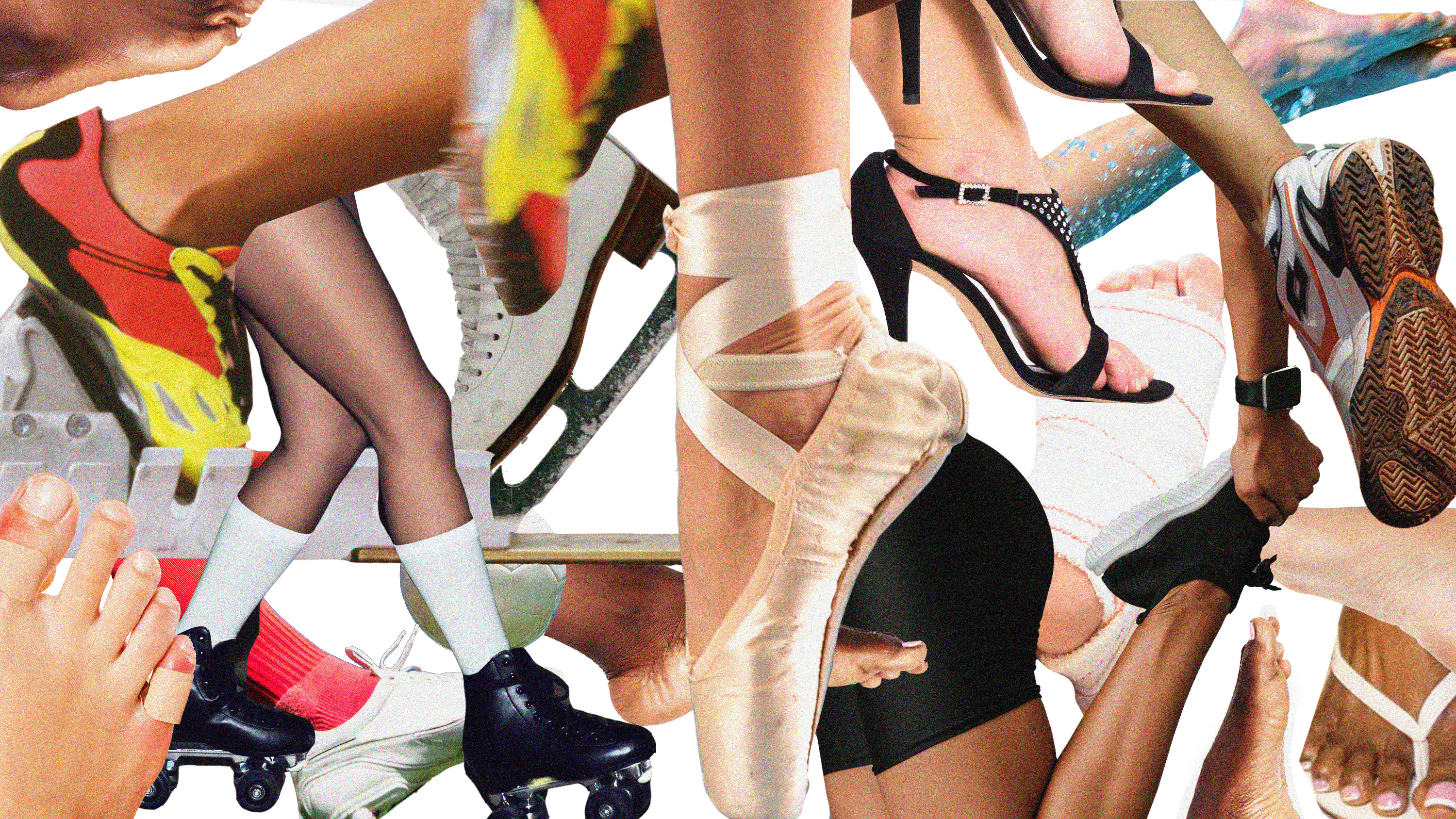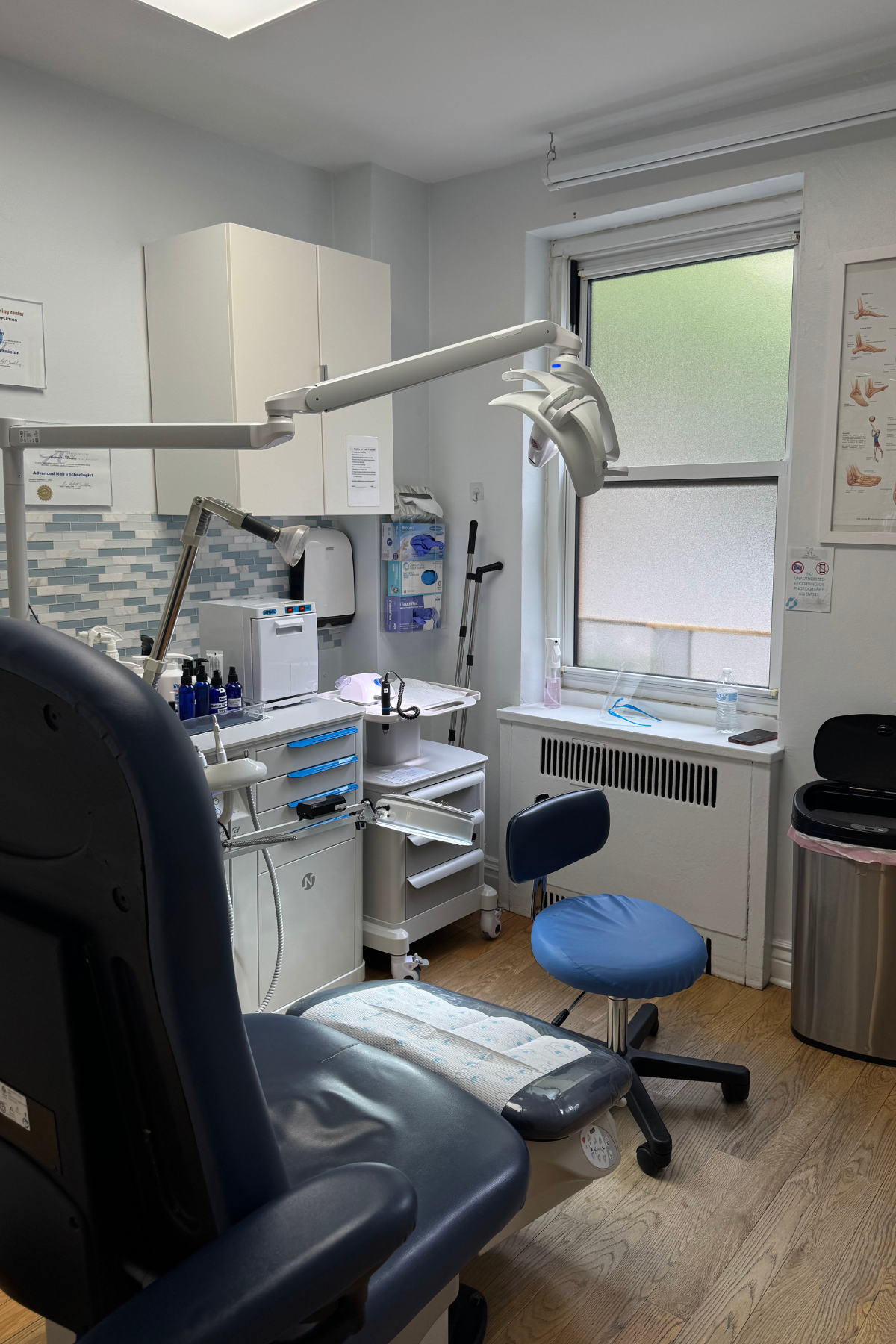What Even Is a Sports Pedicure?
Everything you need to know about the under-the-radar beauty service—including that it's not just for athletes.


Feet pics usually come at a price, but if you’ve ever caught a glimpse of your favorite athletes’ feet, you’d notice they’re in surprisingly great condition. It’s not just good genetics, quality socks, or staying hydrated, either. Many professional athletes regularly receive medical pedicures, also known as sports pedicures, which are clinical-grade treatments that go far beyond your average nail salon experience.
Once reserved for beauty insiders, athletes, or anyone with a podiatrist on speed dial, medical pedicures are now much easier to access. They’ve become the gold standard for anyone who takes foot health seriously, especially as more people realize skincare doesn’t stop at the ankles. These days, nail care is about function as much as it is about aesthetics, and people are investing in treatments that support hygiene, comfort, and long-term wellness.
In the name of research, I booked one myself and spoke to a few pros to find out why the treatment is so beneficial—and so buzzy. Here's what I found out.
What is a medical pedicure?
Unlike a traditional pedicure, which focuses primarily on aesthetics alone, a medical pedicure—or medi-pedi—is a results-driven foot care treatment performed by a licensed podiatrist or a professional trained in both aesthetics and advanced foot health. Board-certified dermatologist, Teresa Song, MD, explains that the service includes a comprehensive assessment of the feet and nails to identify potential issues such as fungal infections, skin thickening, or biomechanical imbalances.
The treatment often involves the meticulous removal of corns, calluses, and dead skin, as well as medically appropriate nail trimming, meaning nails are cut straight across and at the correct length to prevent ingrown toenails or injury (no coffin nails here). There's also an emphasis on long-term foot health, with providers often addressing underlying issues like cracked heels, thickened nails, fungal infections, and recurring ingrown nails.
Medi-pedis are performed in sterile, clinical environments using either disposable or hospital-grade sterilized instruments—a far cry from your local salon or spa. Rather than massage chairs and floral foot soaks, expect a no-frills setup designed to prioritize hygiene, treatment, and prevention.
However, before you book an appointment, it’s important to remember that “as with any service, it’s essential to vet the provider’s qualifications and be prepared to pay more than a standard salon pedicure,” says board-certified dermatologist, Dana Stern, MD. You’ll want to make sure that the practitioner is certified in advanced foot care or licensed in podiatry. “The term ‘medical pedicure’ isn’t regulated and can be used by anyone, so if you’re seeking help for specific concerns like nail infections, corns, or thickened nails, make sure the practitioner is professionally trained to address them.”
Get exclusive access to fashion and beauty trends, hot-off-the-press celebrity news, and more.
How can a medical pedicure benefit people who aren't just athletes?
Whether you're a professional athlete or someone who’s simply on your feet all day, your feet endure a lot. Frequent impact, pressure, and moisture can lead to blisters, nail trauma, calluses, and other recurring issues, explains Marcela Correa, a licensed medical pedicurist and founder of Medi Pedi NYC. Medical pedicures help address these problems at the source by safely removing thickened skin with professional tools, trimming damaged or misshapen nails to reduce pressure points, and using techniques like manual massage or lymphatic stimulation to boost circulation. They can also relieve discomfort caused by tight footwear by softening hardened areas and reducing inflammation, and they support post-workout recovery by improving blood flow and minimizing pressure buildup.
"They enhance overall foot function and performance," Correa says. "Regular treatments also support long-term foot health and reduce the risk of chronic conditions such as plantar fasciitis, recurring fungal infections, or structural imbalances. This is crucial for active individuals where foot health directly impacts performance and injury risk."

Inside a treatment room at the Medi Pedi clinic in Manhattan.
What is the difference between a medical pedicure and a cosmetic one?
Cosmetic pedicures are typically performed by licensed nail technicians who complete a state-approved certification focused on nail aesthetics and basic sanitation. These treatments are mostly about appearance, but they only address the surface. According to Dr. Song, they also follow less stringent hygiene protocols than what you’d find in a clinical setting and aren’t designed to treat or identify real foot health issues.
Medical pedicures, on the other hand, are handled by podiatrists or professionals with advanced foot care training, like registered nurses or certified medical pedicurists. (Medi Pedi NYC, for example, runs its own training program.) These providers are trained in nail and skin pathology, infection control, and treatment protocols that go beyond what a salon offers. The focus is on correcting structural issues, addressing any issues, and improving long-term foot function using medical tools and techniques.
Sanitation is taken seriously, as you can imagine. Practitioners wear gloves, surgical masks, head coverings, and antimicrobial scrubs. Each treatment room is stocked with pre-sterilized tools and single-use files and buffers. After every session, the space is fully cleaned and disinfected, disposable tools are discarded, and a fresh set of sterilized instruments is prepped for the next client.
These treatments aren’t just reactionary—they're preventative. While they do address common issues like calluses, ingrown nails, and fungal infections, they also help spot early signs of inflammation, stress, or infection that could throw off your stride. Keeping your skin and nails in check, and spotting red flags early, can go a long way toward supporting mobility and endurance, whether you’re an athlete or simply an active individual getting older.
What are some signs your feet might need professional help?
According to Dr. Song, persistent pain during walking or training, such as running, weightlifting, or high-impact sports, may be a signal that you could benefit from a medi-pedi. Other red flags include thickened or discolored nails, recurring ingrown toenails, cracked heels, or peeling skin. If any of these issues last longer than two to three weeks without improvement, especially if over-the-counter products aren’t working, it could be time to book a medical pedicure or see a podiatrist. You might also notice abnormal odor or scaling that doesn't improve with consistent at-home care, like regular exfoliation or the use of foot creams.
Correa adds that recurring calluses, brittle or crumbling nails, itching, or unusual tenderness may also indicate fungal infections or underlying stress. “These are signs your feet are under chronic strain,” she says. This kind of strain can come from everyday habits like standing for long periods, walking in unsupportive shoes, or skipping recovery after physical activity. In athletes, it’s often caused by repeated impact, tight footwear, or friction over time. "Without professional care, they can progress into more serious complications."
How often should athletes, or those who put serious stress on their feet, consider getting a medical pedicure?
Both Correa and Dr. Song agree that active individuals or athletes should consider getting a medi-pedi every four to six weeks to maintain healthy nails and skin. “This schedule helps prevent the buildup of stress-related conditions and allows for early intervention if issues start to develop,” says Correa. Regular appointments can also help prevent fungal overgrowth through proper nail trimming, and minimize callus buildup that could lead to cracking or pressure-related pain.
That said, frequency should be based on your specific needs, including your activity level and footwear. For example, if you’re constantly in high heels or unsupportive shoes (here's looking at you, mesh jelly sandals), you may be more prone to foot strain and could benefit from more frequent care.
Foot structure also plays a role. People with flat feet or high arches may be at higher risk for pressure-related conditions or injury and could benefit from more regular treatments. It’s also common for those with these foot types to wear shoes that don’t properly support their structure (guilty!), which can make issues worse. Correa emphasizes the importance of considering underlying health conditions as well, such as diabetes, which can impair circulation and delay healing, or hyperhidrosis, a condition that causes excessive sweating and may lead to fungal infections and skin breakdown if not managed properly.
What is the experience of getting a Medi Pedi like?
While I’m not an athlete by traditional standards (no gold medals, no 5 a.m. practices, no line of buff suitors out the door), I am a boutique fitness studio enthusiast and a New Yorker who thinks a 30-minute walk counts as a five-minute stroll. As a result, I deal with frequent pain from flat feet and, until now, I'd never tried a medical pedicure. I do, however, take basic care of my feet with monthly pedicures at a non-toxic nail studio and the occasional at-home foot mask. But for the sake of journalism, I stepped off my soapbox and booked the appointment.
I went to MediPedi in New York, and my first thought was: Oh, this is serious serious. I walked into a private room that looked more like a dental exam space than the typical nail salons I usually visit, the kind where someone offers you hot tea and meditation headphones. The chair was more like a reclining medical lounger, complete with overhead lighting and sterile instrument trays.
Sometimes you get two technicians for these appointments, but one was tied up. “I'm doing an ingrown nail and then I’ll come help,” she muttered before ducking out. My technician got started right away, removing my polish and asking how long I’d had it on (way too long). My nails were coated in white calcium residue, which she carefully filed and buffed away using a high-speed drill.
The entire treatment is waterless, so there’s no soaking. Instead, they apply a gel callus softener that breaks down tough skin without the need for harsh scrubbing that makes the whole thing feel less harsh. From there, she trimmed my nails using a straight-across technique that helps prevent ingrowns and pressure points, buffed my feet and scrubbed away any rough patches. Somehow I also managed not to kick her in the face despite how ticklish I am.
It felt very similar to a dental cleaning—thorough, clinical, and surprisingly satisfying. I don’t have any major foot concerns, so it wasn’t painful, but I imagine that varies depending on what you’re getting treated. The founder popped in a few times to check on me and even said, “How we doing with these beautiful feet?” I did briefly consider adding that to my Hinge profile.
My appointment took less than 45 minutes, and you could definitely bring your laptop to multitask. At the end, she applied lotion and gently scolded me about the importance of drinking water and moisturizing—two things I’m notoriously bad at. She didn’t apply polish, which makes sense since that’s not really the point of a medical pedicure. Still, I’m now due for a trip to my regular nail salon for a summer color, which is a little annoying.
Over the next few days, I kept looking down at my feet in amazement—partially because I haven’t seen my toes without polish since I was 11, and partially because they just looked clean. Usually, when my polish is removed, my nails look dull and uneven, with white spots or a rough texture. But these looked fresh out of the box. My cuticles were smooth, the nail beds looked even, and the skin on my heels and toes felt noticeably softer.
How much does a Medi Pedi cost?
I tried the basic medical pedicure, which rings in at $206, but the space also offers à la carte pricing for things like gel polish removal, ingrown nails, corns, severely cracked heels, thick calluses, and overgrown or fungal nails. You can also tack on extras like apricot exfoliation, a CBD salve treatment, paraffin wax, nail braces (thin composite bands that help correct curved or ingrown nails), and laser treatments for nail fungus or stubborn skin conditions.
Is a Medi Pedi worth it?
Considering younger generations are more wellness-focused than ever, whether it’s Botox, lymphatic drainage, or longevity supplements, it’s worth keeping foot care in the conversation. You don’t need to go overboard, but if your feet look like they need extra help, they probably do.
Also, if you’re an athlete or just on your feet a lot, this is absolutely worth adding to your maintenance and performance routine. It can help prevent issues like calluses, nail trauma, and inflammation before they start affecting your comfort or mobility. It also gives your feet a level of care that a regular salon pedicure just can't match. Personally, I might not be back anytime soon, mostly because of the high price tag and the fact that my feet aren’t in crisis mode. But if something unsightly happens, I take up foot modeling (times are tough), or become a late-in-life athlete, this is definitely something I’d do again.
So while regular medical pedicures aren’t just for athletes, they’re a practical investment in long-term comfort, mobility, and overall health, especially as we age. It's safe to say that the foot care craze isn't going anywhere.
Meet the Experts

Dr. Teresa Song is a board-certified dermatologist at Marmur Medical in New York City.

Dr. Dana Stern is a Board-Certified Dermatologist and Founder of Dr. Dana. She is well known for her unique expertise, as she is one of the only dermatologists in the country who specialize in the diagnosis, treatment, and surgery of the nail. She is a board certified dermatologist and an assistant clinical professor of Dermatology at the Mount Sinai Medical Center in New York City where she teaches dermatology residents nail surgery.

Marcela Correa is a licensed medical pedicurist and the owner of Medi Pedi NYC.

Iman Balagam is a New York-based freelance writer with several years of experience covering the beauty industry. Balagam's writing has been featured in editorial outlets like Cosmopolitan, Teen Vogue, Byrdie, and Harper's Bazaar.
